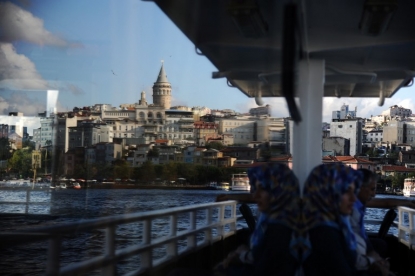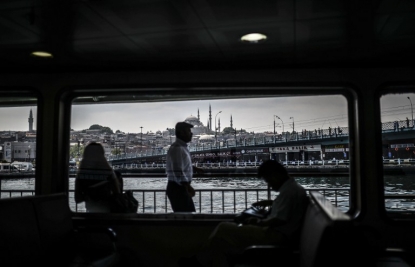Seeking the soul of Istanbul on the Bosphorus
ISTANBUL, April 10, 2015 - It’s commonplace among Istanbul residents to complain about the pace of change in the city. Too much unchecked construction, too much traffic, too many new infrastructure projects, people say. Istanbul is big enough to be a megapolis yet has always had the intimacy of a village. As new luxury apartment blocks sprout from the ground, more cars take to the road and the government comes up with dizzying projects for new bridges, tunnels and an airport, this risks being lost.
Yet everyone still knows a place that for them is the soul of the city. For some it might be among the splashing fountains of the Topkapi Palace. For others, wandering the labyrinthine backstreets of the hills above the Golden Horn. Or perhaps meditating or praying under the mighty domes of one of the city’s great Ottoman mosques.
For me, the easiest way to feel the soul of Istanbul is on the water. On one of the commuter ferries that ply their way on the Bosphorus.
 The Blue Mosque at sundown in January 2014 (AFP Photo / Bulent Kilic)
The Blue Mosque at sundown in January 2014 (AFP Photo / Bulent Kilic)Dividing Europe and Asia, the Bosphorus has presented a formidable obstacle since antiquity to would-be invaders and residents of the city. Sultans of the Ottoman Empire had to be rowed across to Uskudar on the Asian side before starting campaigns in Anatolia. Darius the Great of Persia is said to have engineered a pontoon bridge in a bid to link the divide.
An unbridgeable obstacle
But no permanent crossing was constructed until modern times. The first road bridge was only opened in 1973. A second followed in 1988 and the authorities are now building a third closer to the Black Sea as part of President Recep Tayyip Erdogan’s series of ambitious but hugely controversial engineering projects to transform the face of Turkey. An undersea metro tunnel that runs beneath the Bosphorus was opened in 2013 and there is now even a plan to build a road tunnel under what a few decades before had seemed an unbridgeable obstacle.
But for all that, the simplest and most beautiful way to cross the continents will always be to jump on a boat.
 Passengers travel by ferry on the Bosphorus in August 2013 (AFP Photo / Bulent Kilic)
Passengers travel by ferry on the Bosphorus in August 2013 (AFP Photo / Bulent Kilic)I live on the European side of Istanbul but frequently use the ferries to nip over to the Asian sides to enjoy the markets, pubs and theatres in the slightly decadent Kadikoy district or the stunning Ottoman mosques and waterfront promenade in more conservative Uskudar. After taking a morning run starting from Bebek on the Bosphorus I also sometimes hop on a commuter ferry back to the centre, a journey that takes in hundreds of years of history.
History of this land
For just four lira ($1.5, less with a travel card), the ferry offers the finest view of Istanbul’s famed skyline. The towers of the Topkapi Palace where reclusive sultans ruled an empire spanning continents. The Hagia Sophia, for some simply the greatest single building on the planet, whose journey from church to mosque to museum symbolises the history of this land. The minarets of the Sultanahmet Mosque (Blue Mosque), masterpiece of Ottoman architecture. From the ferry, the morning rush on the streets of Istanbul looks like an attractive bustle, rather than the hellish fight it can be on the ground.
 A businessman rides a ferry on the Bosphorus, from Karakoy to Uskudar in May 2013 (AFP Photo / Bulent Kilic)
A businessman rides a ferry on the Bosphorus, from Karakoy to Uskudar in May 2013 (AFP Photo / Bulent Kilic)The Asian side offers more unexpected pleasures. The beautiful front of Haydarpasa station, built by Germans before World War I as a key point in the Kaiser’s dream of a Berlin-Baghdad railway. The vast Selimiye barracks where the British nurse Florence Nightingale tended to wounded patients from the Crimean War and played a part in revolutionizing hospital treatment.
The groan of foghorns
The ships themselves are beautiful to behold, bedecked in the yellow and white colours of the City Line company. They are the size of a small cruise vessel, with a funnel that belches out inky black smoke which contrasts vividly with the sky. The sound of their foghorns groans balefully around the Bosphorus while the hard-working engines can be heard cranking away even in nearby residential districts.
 People feed seagulls as they travel on the Bosphorus in November 2014 (AFP Photo / Bulent Kilic)
People feed seagulls as they travel on the Bosphorus in November 2014 (AFP Photo / Bulent Kilic)The sounds inside are just as distinctive. The familiar percussive tinkling of spoons against the tulip-shaped Turkish tea glasses as passengers stir alarming amounts of sugar into their small, strong shots of tea. Waiters walk briskly around the cabin with a tray, shouting offers of tea, sandwiches, orange juice or perhaps the winter favourite of sahlep.
The true Istanbullus of course look unfazed by the scenery that dazzles visitors to the city, scowling at their newspapers as tourists from Europe or the Middle East shout excitedly at the spectacular views of the Topkapi Palace.
 Ferry passengers cross the Bosphorus in June 2014 (AFP Photo / Bulent Kilic)
Ferry passengers cross the Bosphorus in June 2014 (AFP Photo / Bulent Kilic)I’ve noticed that reading a newspaper in Turkey can be as vivid a display of one’s political affiliations as wearing a football shirt can be of one’s favourite team. That man in the corner reading Yeni Safak (New Dawn, strongly pro-government), well, he has to be a strong supporter of Erdogan. The other man reading Sozcu (The Spokesman, rabidly anti-government) can harbour nothing other than an impassioned hatred for Turkey’s divisive president. What about the woman reading Hurriyet (Liberty)? Hard to say, the paper treads a careful line these days in the vain hope of not alienating any readers.
A nautical ballet
Karakoy to Kadikoy, Besiktas to Uskudar, Eminonu to Kadikoy, the ferries leave once every half hour from around six am until midnight in a nautical ballet jointly performed with the cargo ships coming through the Bosphorus and tiny fishing vessels. It seems a chaos and remarkable that more accidents don’t happen in such a crowded space.
 A girl feeds seagulls on a ferry across the Bosphorus in November 2014 (AFP Photo / Bulent Kilic)
A girl feeds seagulls on a ferry across the Bosphorus in November 2014 (AFP Photo / Bulent Kilic)Joining the party is an extraordinarily rich birdlife. Cormorants dive for fish and then emerge, shaking their head as if in annoyance. Herons stand sentry on the breakwaters, gazing out to the Hagia Sophia like they have seen it all before. The city’s most distinctive birds, the Yelkouan Shearwaters, fly rapidly in flocks low to the water towards the Sea of Marmara, themselves like anxious early morning commuters. And even from the city centre it’s possible on occasion to see groups of dolphins leaping out of the water.
Slow, stately travel
As well as the ferries that cross from Europe to Asia, rarer but much-loved ferries sail on the route down the Bosphorus from the Black Sea to the Sea of Marmara. Just a handful are timetabled, taking commuters from the villages on the northeastern side towards the centre and then back in the evening. This is slow, stately travel, taking two hours to make the full trip - the morning ferry that leaves Anadolu Kavagi close to the Black Sea at 6:40 am eases its way into Eminonu in the centre at 8:30 am. But while driving takes perhaps a quarter of the time, I always think, what travel this is.
 A Turkish couple shares a romantic sunset at the back of a ferry on the Bosphorus in October 2014 (AFP Photo / Bulent Kilic)
A Turkish couple shares a romantic sunset at the back of a ferry on the Bosphorus in October 2014 (AFP Photo / Bulent Kilic)On the way, the great waterfront yali mansions built for the Ottomans and now used by the new royalty of the super rich. The Anadolu Hisari fortress built in the late 1390s by Sultan Beyazit I, over half a century before the Ottoman conquest of Constantinople. The waterfront Dolmabahce Palace from where the final Ottoman sultans watched their empire crumble and where the founder of the modern Turkish Republic, Mustafa Kemal Ataturk, took his final breath. And as the journey nears its end, the Topkapi Palace, Hagia Sophia and the great Ottoman mosques of Sultanahmet and Suleymaniye, triumphant in their permanence.
In a few years’ time, if Erdogan’s vision is realised, it will likely be possible to cross the Bosphorus in every conceivable way, by tunnel, long distance train or whatever. But I think many, be they Istanbullus or visitors, will keep a preference for the ferry. And myself as well. Let time move slower, nurse a boiling tea in your hands, sit back and watch history shimmer above the glittering waters.
Stuart Williams is an AFP correspondent based in Istanbul
 The Kadikoy ferry leaves Besiktas harbour in Istanbul in October 2013 (AFP Photo / Bulent Kilic)
The Kadikoy ferry leaves Besiktas harbour in Istanbul in October 2013 (AFP Photo / Bulent Kilic)

